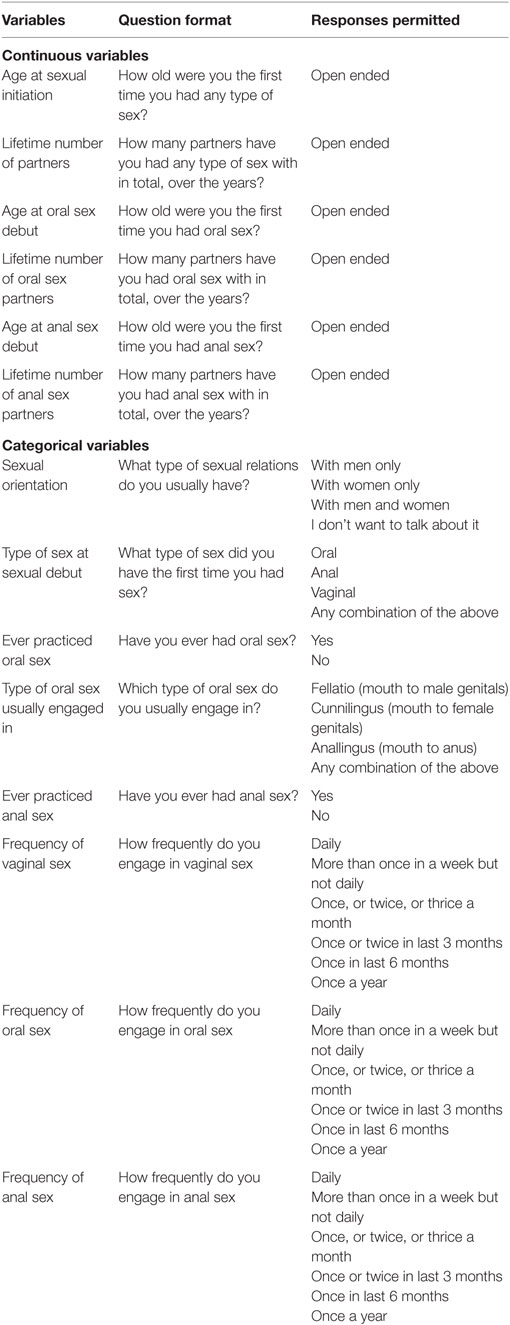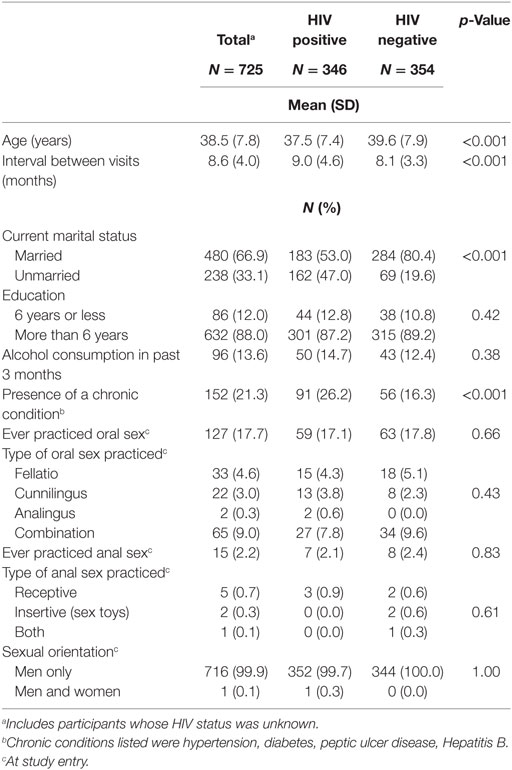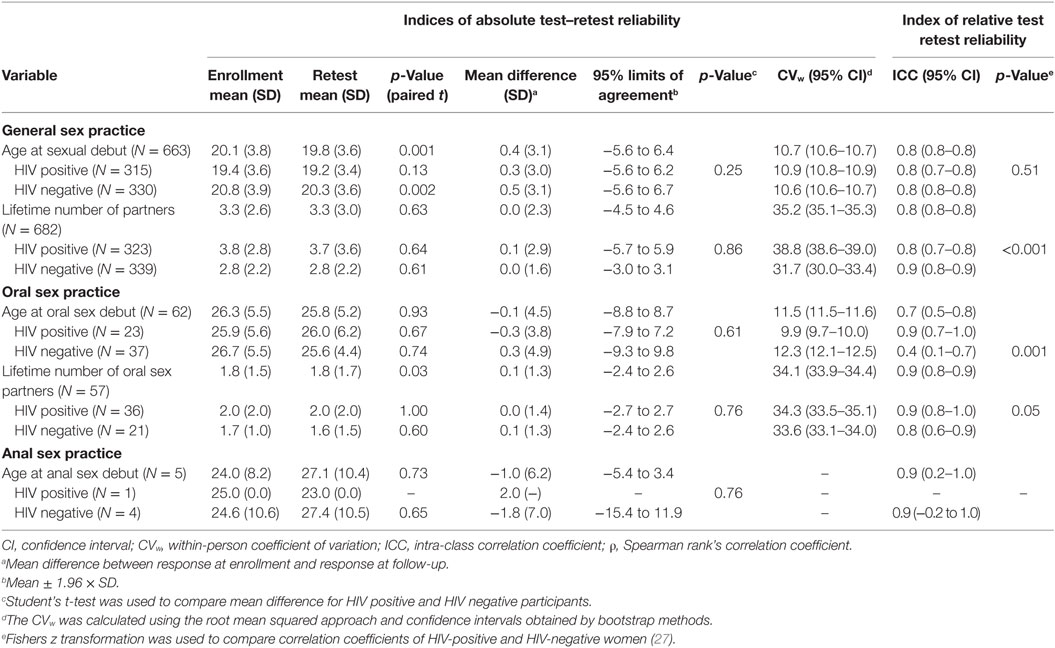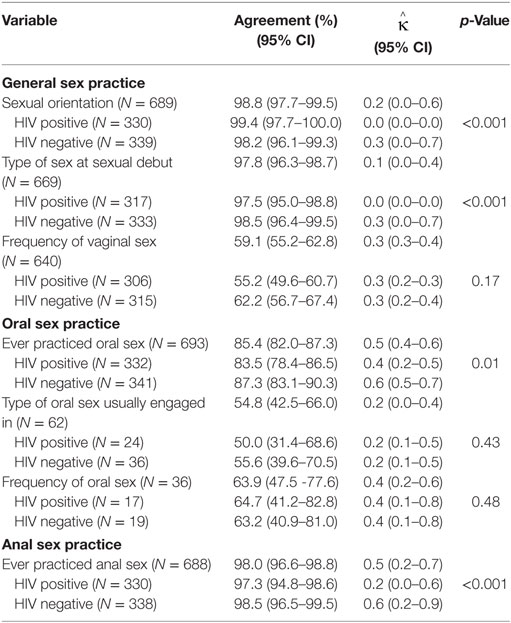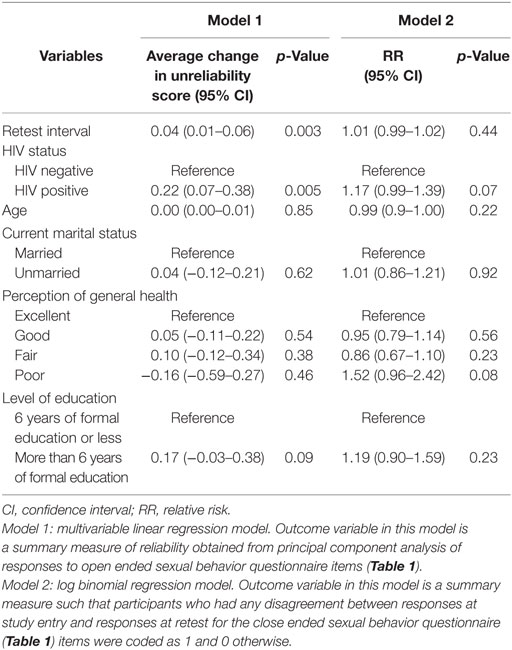- 1Department of Public Health and Primary Care, University of Cambridge, Cambridge, United Kingdom
- 2Institute of Human Virology Nigeria, Abuja, Nigeria
- 3Division of Cancer Epidemiology, Department of Epidemiology and Public Health, University of Maryland School of Medicine, Baltimore, MD, United States
- 4University of Maryland Marlene and Stewart Greenebaum Comprehensive Cancer Center, University of Maryland School of Medicine, Baltimore, MD, United States
- 5Department of Epidemiology, Harvard T.H Chan School of Public Health, Boston, MA, United States
- 6Institute of Human Virology, University of Maryland School of Medicine, Baltimore, MD, United States
Background: Studies assessing risk of sexual behavior and disease are often plagued by questions about the reliability of self-reported sexual behavior. In this study, we evaluated the reliability of self-reported sexual history among urbanized women in a prospective study of cervical HPV infections in Nigeria.
Methods: We examined test–retest reliability of sexual practices using questionnaires administered at study entry and at follow-up visits. We used the root mean squared approach to calculate within-person coefficient of variation (CVw) and calculated the intra-class correlation coefficient (ICC) using two way, mixed effects models for continuous variables and statistics for discrete variables. To evaluate the potential predictors of reliability, we used linear regression and log binomial regression models for the continuous and categorical variables, respectively.
Results: We found that self-reported sexual history was generally reliable, with overall ICC ranging from 0.7 to 0.9; however, the reliability varied by nature of sexual behavior evaluated. Frequency reports of non-vaginal sex (agreement = 63.9%, 95% CI: 47.5–77.6%) were more reliable than those of vaginal sex (agreement = 59.1%, 95% CI: 55.2–62.8%). Reports of time-invariant behaviors were also more reliable than frequency reports. The CVw for age at sexual debut was 10.7 (95% CI: 10.6–10.7) compared with the CVw for lifetime number of vaginal sex partners, which was 35.2 (95% CI: 35.1–35.3). The test–retest interval was an important predictor of reliability of responses, with longer intervals resulting in increased inconsistency (average change in unreliability for each 1 month increase = 0.04, 95% CI = 0.07–0.38, p = 0.005).
Conclusion: Our findings suggest that overall, the self-reported sexual history among urbanized Nigeran women is reliable.
Introduction
Information about sexual behavior and sexual health is often collected in epidemiologic studies. These include research on risk factors for acquisition and spread of communicable diseases such as sexually transmitted diseases including HIV/AIDS and on non-communicable diseases such as cancers. Sexual history is relevant in diseases where it does not have direct etiological relationship but where it may provide insights into overall well-being and quality of life, or where disease may negatively affect the sexual domain. Examples include chronic illnesses such as stroke and diabetes, whose progression, treatment, or resolution may affect sexual function and quality of life.
In most epidemiologic studies, the history of sexual practices and sexual hygiene are elicited through self-reports but the validity of such data has been repeatedly questioned (1–3). In the absence of precise biomarkers that can serve as gold standards to evaluate the accuracy of self-reports, several studies have been done to evaluate methods of testing the reliability. The most popular method is the use of test–retest correlation of responses to questionnaires while another method uses the presence of biomarkers of vaginal exposure to semen such as the presence of sperm, prostate-specific antigen, or Y chromosome in vaginal fluids (4–8). These latter methods are more relevant for evaluation of recent unprotected sexual intercourse in women and may not be relevant in most epidemiological studies where long-term exposure and variety of exposures are of interest (9). Other methods that have been used include correlation of partner reports of sexual behavior and the use of sexual diaries (2, 9). Partner’s reports of sexual behavior is not ideal because it may be influenced by the nature of the relationship between partners and raises problems of confidentiality in reporting on the behavior of another. The use of sexual diaries in large, population-based studies may not be practicable because of the burden on research participants, which may lead to high attrition rates, non-compliance, recall bias, and participants’ reactivity (2, 9–11).
Studies that used test–retest correlations for measuring reliability of sexual history among diverse populations in the United States have yielded intraclass correlation coefficients (ICC) ranging from 0.3 to 0.9 for reports of lifetime number of sexual partners (9, 12–15). Most studies in low- and middle-income countries (LMICs) that have evaluated the reliability of self-reported sexual history have been restricted to either the young (15–24 years old) or to practitioners of high-risk sexual behavior (16, 17). One possible reason for high prevalence of these types of research in LMIC is that sexual behavior is commonly used as indicators for monitoring the HIV/AIDS epidemic by the Joint United Nations Program on HIV/AIDS (UNAIDS) (18). As self-report of sexual behavior may be subject to self-presentation and social desirability bias, which may differ by age, sex, and population characteristics that reflect acceptable norms and cultural attitudes toward talking about sex in any given society, it is important to evaluate reliability in the context of conducting epidemiological research in resource limited settings (6).
In this study, we examined a 14-item questionnaire used to collect sexual behavior history from urbanized Nigerian women to determine its reliability and that of similar instruments used for self report of sexual behavior in epidemiological research.
Materials and Methods
Study Population
Between August 2012 and December 2013, we recruited women from our cervical cancer screening clinics in Abuja, Nigeria, into a prospective study of the host and viral factors associated with persistent hrHPV infection in Nigeria. We enrolled women who were at least 18 years old and had engaged in vaginal sexual intercourse. We excluded women who had a total hysterectomy, were pregnant, or unable to provide an informed consent. At enrollment, we used interviewer administered questionnaires to collect data on sociodemographic characteristics, lifestyle risk factors, reproductive and sexual behavior histories. Trained nurses performed gynecologic examinations on all participants, collected biological samples for HPV detection, and examined the cervix for premalignant lesions through visual inspection with acetic acid/Lugol’s reagent (VIA/VILI). We treated all women diagnosed with premalignant cervical lesions with thermocoagulation if the lesions met specific criteria: complete visualization of the lesions, lesions covering less than 75% of the transformation zone, lesions amenable to complete coverage by the tip of the cryoprobe and lesions not suspicious of cancer (19). All participants were scheduled for a follow-up visit after 6 months. At the follow-up visit, the same nurses who administered the baseline questionnaires readministered the questionnaires to all returning participants. At the baseline visit, participants were not informed that they would be asked the same questions at follow-up. All nurses were trained to administer the questionnaires either in English or local languages in cases where participants could not speak English. All questionnaires were completed prior to biological sample collection.
Main Outcome Measures
We adapted protocols for sexual behavior history from the Phenx toolkit version 5.0 February 24, 2012 and developed a 14-item questionnaire. We piloted the questionnaires among 50 women of reproductive age with similar characteristics as our study population. Details of these items and coding of responses are shown in Table 1. Six items were coded as continuous variables while eight items were coded as categorical. To distinguish between actual behavior change and test–retest reliability, we asked all participants to report changes in sexual behavior in the period between the first and second questionnaires, and adjusted our analysis to account for any reported changes.
Statistical Analysis
For categorical variables, we estimated kappa coefficient to determine agreement beyond what would be expected by chance. We estimated 95% confidence intervals (95% CI) for using bootstrap methods with bias-corrected estimation as some of the variables such as type of sex at sexual debut, and types and frequency of practice of different types of sex had more than two categories (20–22). We compared the statistics for HIV-negative and HIV-positive women using the z statistic (23). We used the Landis and Koch benchmarks to interpret kappa values: <0.00 (poor), 0.00–0.20 (slight), 0.21–0.40 (fair), 0.41–0.60 (moderate), 0.61–0.80 (substantial), 0.81–1.00 (almost perfect) (24).
For continuous variables, we calculated indices of absolute and relative test–retest reliability. For absolute reliability, the degree to which repeated responses varied for individuals, we used within person coefficients of variation (CVw), Bland and Altman’s limit of agreement, paired t-tests, differences in responses at study entry and retest. For relative reliability, the degree to which individuals maintain their position in the group, we used ICCs two-way mixed effects model. We chose to use the two-way mixed effects ICC model because the same set of research assistants administered the same questionnaires to all participants at study entry and retest. Therefore, the research assistants and questionnaires were considered to be fixed effects while the random effects were participants and possibly the interactions between participants and the research assistants. We used the guidelines suggested by Cicchetti to interpret the correlation coefficients, with values below 0.40 interpreted as poor; values of 0.40–0.59 as fair; values of 0.60–0.74 as good, and values of 0.75–1.00 as excellent (25).
To investigate the association between potential correlates and test–retest reliability, we used two different types of regression models; log binomial regression models for sexual behavior responses collected as categorical variables; and linear regression models for sexual behavior response collected as continuous variables (Table 1). We evaluated age-adjusted models of the outcome and the potential predictors such as interval between test administration, marital status, level of education, self-perception of general health and HIV status, and others identified from the literature. We identified predictors with p-values less than 0.20 in the age-adjusted models and included them in multivariable regression models (9, 26).
We used principal component analysis to create a summary measure of reliability for the continuous variables. Using the eigenvalue cutoff of 1, the scree plot, and interpretability of factors, we retained one factor, which explained a cumulative variance of 53%. We predicted scores for test–retest reliability using the factor loadings for the retained factor, such that participants with high scores may be considered to have higher levels of inconsistency in their responses compared with participants with low scores. We used the summary measure in linear regression models testing for test–retest reliability for each participant (Table 1).
For the categorical variables (Table 1), we created a summary variable such that participants who had any disagreement in the categorical variables at test and retest had a score of one and participants who were consistent in their test–retest responses had a score of 0. Next, we used this summary measure in log binomial models to evaluate the association between potential correlates and reliability of responses provided for sexual behavior questions collected as categorical variables (Table 1).
We considered a p-value <0.05 as significant. Formal adjustments for multiplicity were not considered appropriate as inferences for itemized questionnaire items were not based on significance of individual endpoints. In regression models, where inferences were based on significance of the endpoint, we used summary variables as endpoints. All statistical analyses were conducted using Stata version 13 (Stata Corp, College Station, TX, USA).
Results
Study Characteristics
Of the 725 participants included in this study, 346 (48%) were HIV positive, 354 (49%) were HIV negative, and the HIV status of 25 (3%) participants was unknown. The latter were excluded from regression models and comparisons of reliability between HIV-positive and HIV-negative participants. The mean (SD) age of participants was 38.5 (7.8) years and mean (SD) interval between questionnaire administrations was 8.6 (4.0) months (Table 2). Most of the participants were married (67%) and had more than 6 years of formal education (88%). The prevalence of oral and anal sex among the participants at study entry was 16 and 2%, respectively.
Indices of Absolute Reliability
The mean of the difference (SD) in responses provided at study entry and at retest for all but one of the continuous variable was close to 0 [age at sexual debut, 0.4 (3.1); lifetime number of partners, 0.0 (2.3); age at oral sex debut, −0.1 (4.5); lifetime number of oral sex partners 0.1 (1.3); age at anal sex debut −1.0 (6.2)] (Table 3). Except for age at oral and anal sex debut, the responses provided at retest were generally lower than the responses provided at baseline as shown by the positive direction of the mean of the difference between the responses (Table 3). The 95% limits of agreement for the mean of the differences between responses at study entry and retest are shown in the Bland and Altman plots (Figure 1). The plots show that with increasing number of sexual partners reported, the less reliable the responses were. Comparing HIV-negative women to HIV-positive women in univariate analyses, there were no significant differences for the sexual history measures collected as continuous variables: age at sexual initiation (p 0.25), lifetime number of partners (p 0.86), age at oral sex debut (p 0.61), lifetime number of sexual partners (p 0.76), and age at anal sex debut (p 0.76).
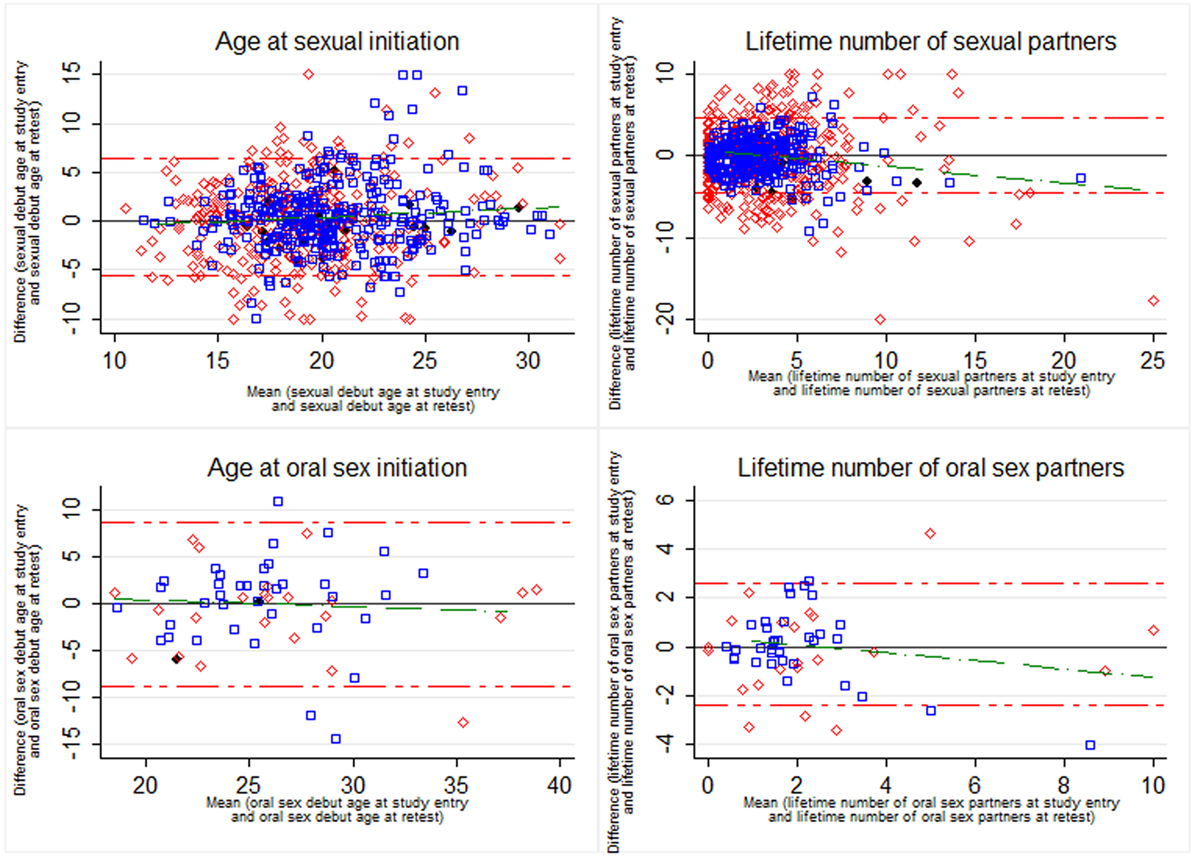
Figure 1. Bland and Altman plots of responses provided at study entry and retest for age at sexual initiation, age at oral sex initiation, lifetime number of sexual partners, and lifetime number of oral sex partners.  represent HIV-negative women,
represent HIV-negative women,  represent HIV-positive women, and
represent HIV-positive women, and  represents women with unknown HIV status. The red etched lines represent the 95% agreement limits (1.96 × SD of the differences). The green etched line represents a regression line fitting the paired differences to the pairwise means.
represents women with unknown HIV status. The red etched lines represent the 95% agreement limits (1.96 × SD of the differences). The green etched line represents a regression line fitting the paired differences to the pairwise means.
The intraindividual variability were lower for time-invariant measures (age at sexual debut CVw = 10.7 and age at oral sex debut CVw = 11.5) compared with frequency measures (lifetime number of partners CVw = 35.2, and lifetime number of oral sex partners CVw = 34.1) (Table 3).
Indices of Relative Reliability
As shown in Table 3, the ICC for age at sexual debut (0.8), total lifetime number of partners (0.8), age at oral sex debut (0.7), and total lifetime number of oral sex partners (0.9) for the total study population was excellent.
HIV-negative women had a ICC than HIV-positive women for lifetime number of partners (0.9 vs 0.8, p < 0.001). Conversely, HIV-negative women had a lower ICC than HIV-positive women for age at oral sex debut (0.4 vs 0.9, p 0.001).
Agreement for Categorical Variables
There was a high level of agreement between responses at study entry and responses at retest for sexual orientation (98.8%), type of sex at sexual debut (97.8%), ever practiced oral sex (85.4%), ever practiced anal sex (98.2%) (Table 4). However, agreement for frequency of sexual activity was relatively lower ranging from 59.1% for frequency of vaginal sex to 63.9% for oral sex. Despite the high levels of agreement, statistics were slight to moderate. Generally, HIV-negative individuals had higher statistics than HIV-positive individuals.
Predictors of Reliability
In Model 1 for continuous variables, we found that a 1-month increase in test–retest interval resulted in an average increase of 0.04 points in inconsistency of responses (95% CI = 0.01–0.06, p-value = 0.003) (Table 5). HIV infection was also statistically significantly associated with reliability, with HIV-positive individuals having an average increase of 0.22 points in inconsistency compared to HIV-negative individuals (95% CI = 0.07–0.38, p-value = 0.005). In Model 2 for categorical variables, we did not observe any significant relationships.
Discussion
In this study of test–retest reliability of self-reported sexual behavior using interviewer administered questionnaires, we found that self-report of sexual behaviors was reasonably reliable overall. However, we observed varying levels of reliability based on the nature of sexual behavior reported. The reports on frequency of non-vaginal sexual practices were more reliable than those of vaginal sexual practices. Differences in the patterns of reliabilities for frequency of vaginal and non-vaginal sexual practices may reflect differences in the frequencies of the behaviors. Among heterosexual women, vaginal sexual practices tend to occur more frequently than non-vaginal sexual practices (14). Reports of less frequent behavior are generally more stable, as people tend to use more efficient recall strategies (28, 29). Enumeration recall strategies, where each event is recalled and counted separately are commonly used for infrequent behaviors, especially when these behaviors are associated with particularly distinctive time periods, events, or people. However for frequent behaviors, enumeration may be too difficult or time consuming; therefore, estimation recall strategies where rate-based mental calculations are made without recalling individual events are commonly used (30–32).
We found that reports of time-invariant events (age at sexual debut, ever-practiced oral sex, ever-practiced anal sex) were more reliable than frequency reports (number of partners, frequency of sex). This finding may reflect the different psychological processes that underlie these two types of reports. Time-invariant events may be associated with more vividness and personal salience, especially when accompanied with strong emotions at the time of the encounter, for example, age at sexual initiation or ever practiced anal sex (9). Conversely, frequency reports that asks about number of events may involve less vivid memories especially in people with high levels of sexual networking. This is further complicated by the need for rate-based inferences, which require mental calculations that can be inconsistent (9, 11, 30).
For continuous measures, reliability was also significantly decreased with increasing interval between questionnaire administration after controlling for age, HIV status, marital status, perception of general health, and level of education. One possible explanation for our finding is the possibility that behaviors may change with increasing intervals between tests and, therefore, responses provided at retest may reflect current behavior at the time of test administration rather than an indication of instability. Several research studies have evaluated the relationship between recall periods and reliability. Results from some of these studies showed that shorter recall periods were more reliable than longer recall periods (9, 33). On the other hand, other studies reported no association or increased reliability for longer recall periods for particular behaviors such as lifetime number of sexual partners (15, 30, 34). These varying results may reflect underlying differences in the nature of behaviors evaluated, mode of assessment, and study population as can be observed from the results from our models that evaluate reliability for variables collected as categorical where there were no associations between HIV status, test–retest interval, and reliability. While our results provide the only estimates for women living in an urban community in Nigeria, similar findings have been reported in adolescent populations in South Africa (35). The optimal recall period for studies on sexual risk remains an active area of research (2).
Although the indices for absolute test–retest reliability for lifetime number of partners showed high levels of reliability, responses were less reliable as the self-reported number of partners increased, which is consistent with results from previous studies (10, 29, 30, 36). This may be explained by a combination of several factors, such as different recall strategies and the attitudinal propensity toward casual sex among people with multiple sexual partners compared to people who claim to be abstainees or monogamists (30). Participants who have been sexually inactive or monogamous during the recall period may use enumeration strategies to report 0 or 1, respectively. Whereas participants who have had multiple sexual partners may use rate-based mental calculations, which yield imprecise estimates. The cognitive processes involved in the abstinent or monogamous participant are straightforward and probably result in higher degrees of reliability than in women reporting multiple sexual partners. Additionally, studies show that people with higher numbers of sexual partners display more favorable attitudes toward casual sex, which tend to be less vivid with less psychological involvement than sex in the context of sustained relationships (30). As recall is associated with vividness of events, it is understandable that discrepancies are higher with increasing number of partners (37).
Strengths of this Study
A notable strength of our study is that we evaluated reliability of individual sexual behaviors, rather than assume that reliability of measures of one sexual behavior confer reliability on other measures of sexual behavior. This has important implications for researchers in making informed decisions about the collection of self reported sexual history.
In estimating sample size for epidemiologic studies, the importance of considering measurement errors of important covariates has been described by several authors (38, 39). One simple approach is to adjust the sample size estimates based on desired level of statistical power and level of precision in the presence of perfect measurements, by the square of the correlation between the true value and the observed covariate value (38). An alternative to sample size adjustments is to incorporate expected levels of measurement error into the data analysis (40). These approaches require that the magnitude of the measurement error for the covariates are known. In the absence of correlation, estimates for true and self-reported sexual behavior history, due to difficulties in determining the true values, our test–retest correlation estimates provide some guidance for sample size adjustments to account for measurement errors in the use of self-reported sexual behavior history in epidemiologic studies. Another strength of our study is that by examining a time-invariant sexual attribute such as age at sexual debut, we were able to evaluate test–retest reliability without the confounding effects of behavior change that may occur during the test interval. For time-variant measures such as lifetime number of sexual partners, we included a question in the retest questionnaire for participants to record number of new partners since the administration of the first test.
Motivation to participate in a research study and topic of research study may be important sources of response bias (41). Participants in reproductive and sexual health research studies may give more thoughtful responses to questions on sexual practices because of altruistic reasons in aiding investigators to arrive at useful answers or they may perceive that their responses may affect their clinical management, leading to better reliability than participants in other types of studies, where sexual behavior may not be perceived as being important. Our study was hospital-based and conducted among adult females in the context of cervical cancer screening; therefore, our participants may have given responses that can be generalized to populations who participate in similar research.
Limitations
In our study, we used interviewer administered in-person interviews, and this may have led participants to provide more socially desirable responses. We minimized interviewer influences by using well-trained interviewers and by arranging sensitive questions after less sensitive ones so that the participants’ trust would be high by the time sensitive questions were asked. There is some evidence to suggest that participants respond more objectively to self-administered interviews than to interviewer-administered ones, particularly for behaviors that may be considered embarrassing, stigmatizing, or illegal (42). This may be due to increased privacy afforded by self-administered interviews and ability of participants to control the pace of the interview. However, other studies have found no difference in the use of either methods, especially for sexual behavior history that may include complex branch and skip patterns (43). Audio-assisted computer self-administered questionnaires may improve objectivity of self-administered questionnaires, but they require respondents to comprehend questions and provide relevant responses. Their infrastructural demands and literacy requirements may preclude their use in large scale epidemiological studies in LMICs (44, 45).
Although the statistic is important in evaluating agreement beyond chance for categorical variables, it is highly dependent on prevalence and marginal totals (46). Thus, low values will be obtained despite high percent agreement when prevalence of traits is low, as observed with prevalence of anal sex practice (2.2%), and also when marginal totals are highly asymmetric, as was observed with sexual orientation, and type of sex practiced at sexual debut in this study population.
Given the prevalence of oral and anal sex in this study population, our sample size may have limited power in detecting small differences between responses provided at study entry and retest for questionnaire items on oral and anal sex.
Conclusion
Our study provides valuable insight on the reliability of sexual behavior history data for studies conducted in developing countries and shows that the overall test–retest reliability of sexual behavioral history among urbanized adult women in Nigeria is high. Relative indices of reliability were generally high and within person variability was higher for frequency measures compared to time-invariant measures. This implies that with well-trained interviewers and carefully formatted questionnaire items, researchers can utilize self-reported sexual history data in epidemiological studies in LMICs.
Ethics Statement
All participants gave written informed consent in accordance with the Declaration of Helsinki. The protocol was approved by the National Health Research Ethics Committee of Nigeria and the University of Maryland Institutional Review Board.
Author Contributions
ED, SA, OE, and MO contributed to the acquisition, analysis, interpretation of data, and drafting of the manuscript. PP contributed to the interpretation of data and revising it critically for important intellectual content. CA contributed to the conception, design, interpretation of data, critical revision of the manuscript for intellectual content, and obtained funds for the study. All authors approved the final version of this paper.
Conflict of Interest Statement
The authors declare that the research was conducted in the absence of any commercial or financial relationships that could be construed as a potential conflict of interest.
Funding
This study was funded by NIH grant—Capacity Development for Research in AIDS Associated Malignancies NIH/NCI 1D43CA153792 and African Collaborative Center for Microbiome and Genomics Research grants (NIH/NHGRI U54HG006947). The content is solely the responsibility of the authors and does not necessarily represent the official views of the National Institutes of Health.
References
1. Weinhardt LS, Forsyth AD, Carey MP, Jaworski BC, Durant LE. Reliability and validity of self-report measures of HIV-related sexual behavior: progress since 1990 and recommendations for research and practice. Arch Sex Behav (1998) 27(2):155–80. doi:10.1023/A:1018682530519
2. Schroder KE, Carey MP, Vanable PA. Methodological challenges in research on sexual risk behavior: II. Accuracy of self-reports. Ann Behav Med (2003) 26(2):104–23. doi:10.1207/S15324796ABM2602_03
3. DiClemente RJ, Swartzendruber AL, Brown JL. Improving the validity of self-reported sexual behavior: no easy answers. Sex Transm Dis (2013) 40(2):111–2. doi:10.1097/OLQ.0b013e3182838474
4. Aho J, Koushik A, Diakite SL, Loua KM, Nguyen VK, Rashed S. Biological validation of self-reported condom use among sex workers in Guinea. AIDS Behav (2010) 14(6):1287–93. doi:10.1007/s10461-009-9602-6
5. Gallo MF, Behets FM, Steiner MJ, Thomsen SC, Ombidi W, Luchters S, et al. Validity of self-reported ‘safe sex’ among female sex workers in Mombasa, Kenya – PSA analysis. Int J STD AIDS (2007) 18(1):33–8. doi:10.1258/095646207779949899
6. Gallo MF, Behets FM, Steiner MJ, Hobbs MM, Hoke TH, Van Damme K, et al. Prostate-specific antigen to ascertain reliability of self-reported coital exposure to semen. Sex Transm Dis (2006) 33(8):476–9. doi:10.1097/01.olq.0000231960.92850.75
7. Anderson C, Gallo MF, Hylton-Kong T, Steiner MJ, Hobbs MM, Macaluso M, et al. Randomized controlled trial on the effectiveness of counseling messages for avoiding unprotected sexual intercourse during sexually transmitted infection and reproductive tract infection treatment among female sexually transmitted infection clinic patients. Sex Transm Dis (2013) 40(2):105–10. doi:10.1097/OLQ.0b013e31827938a1
8. Ghanem KG, Melendez JH, McNeil-Solis C, Giles JA, Yuenger J, Smith TD, et al. Condom use and vaginal Y-chromosome detection: the specificity of a potential biomarker. Sex Transm Dis (2007) 34(8):620–3. doi:10.1097/01.olq.0000258318.99606.d9
9. Catania JA, Gibson DR, Chitwood DD, Coates TJ. Methodological problems in AIDS behavioral research: influences on measurement error and participation bias in studies of sexual behavior. Psychol Bull (1990) 108(3):339–62. doi:10.1037/0033-2909.108.3.339
10. McCallum EB, Peterson ZD. Investigating the impact of inquiry mode on self-reported sexual behavior: theoretical considerations and review of the literature. J Sex Res (2012) 49(2–3):212–26. doi:10.1080/00224499.2012.658923
11. Fenton KA, Johnson AM, McManus S, Erens B. Measuring sexual behaviour: methodological challenges in survey research. Sex Transm Infect (2001) 77(2):84–92. doi:10.1136/sti.77.2.84
12. Schlecht NF, Franco EL, Rohan TE, Kjaer SK, Schiffman MH, Moscicki AB, et al. Repeatability of sexual history in longitudinal studies on HPV infection and cervical neoplasia: determinants of reporting error at follow-up interviews. J Epidemiol Biostat (2001) 6(5):393–407. doi:10.1080/135952201753337149
13. Brener ND, Kann L, McManus T, Kinchen SA, Sundberg EC, Ross JG. Reliability of the 1999 youth risk behavior survey questionnaire. J Adolesc Health (2002) 31(4):336–42. doi:10.1016/S1054-139X(02)00339-7
14. Durant LE, Carey MP. Reliability of retrospective self-reports of sexual and non-sexual health behaviors among women. J Sex Marital Ther (2002) 28(4):331–8. doi:10.1080/00926230290001457
15. Nyitray AG, Harris RB, Abalos AT, Nielson CM, Papenfuss M, Giuliano AR. Test-retest reliability and predictors of unreliable reporting for a sexual behavior questionnaire for U.S. men. Arch Sex Behav (2010) 39(6):1343–52. doi:10.1007/s10508-009-9522-6
16. Phillips AE, Gomez GB, Boily MC, Garnett GP. A systematic review and meta-analysis of quantitative interviewing tools to investigate self-reported HIV and STI associated behaviours in low- and middle-income countries. Int J Epidemiol (2010) 39(6):1541–55. doi:10.1093/ije/dyq114
17. Dare OO, Cleland JG. Reliability and validity of survey data on sexual behaviour. Health Transit Rev (1994) 4(Suppl):93–110.
18. Slaymaker E. A critique of international indicators of sexual risk behaviour. Sex Transm Infect (2004) 80(Suppl 2):ii13–21. doi:10.1136/sti.2004.011635
19. Sellors JW, Sankaranarayanan R. Colposcopy and Treatment of Cervical Intraepithelial Neoplasia: A Beginner’s Manual. Lyon: Diamond Pocket Books (P) Ltd (2003).
20. Efron B, Tibshirani RJ. An Introduction to the Bootstrap. Boca Raton, FL: Chapman & Hall/CRC Press (1994).
21. Stine R. An introduction to bootstrap methods examples and ideas. Sociol Methods Res (1989) 18(2–3):243–91. doi:10.1177/0049124189018002003
22. Lee J, Fung KP. Confidence interval of the kappa coefficient by bootstrap resampling. Psychiatry Res (1993) 49(1):97–8. doi:10.1016/0165-1781(93)90033-D
23. Fleiss JL, Levin B, Paik MC. Statistical Methods for Rates and Proportions. Hoboken, NJ: John Wiley & Sons (2013).
24. Landis JR, Koch GG. The measurement of observer agreement for categorical data. Biometrics (1977) 33(1):159–74. doi:10.2307/2529310
25. Cicchetti DV. Guidelines, criteria, and rules of thumb for evaluating normed and standardized assessment instruments in psychology. Psychol Assess (1994) 6(4):284–90. doi:10.1037/1040-3590.6.4.284
26. Mark KP, Smith RV, Young AM, Crosby R. Comparing 3-month recall to daily reporting of sexual behaviours. Sex Transm Infect (2016) 93(3):196–201. doi:10.1136/sextrans-2016-052556
27. Fisher RA. On the probable error of a coefficient of correlation from a small sample. Metron (1921) 1:3–32.
28. Tourangeau R, Smith TW. Asking sensitive questions: the impact of data collection mode, question format, and question context. Public Opin Q (1996) 60(2):275–304. doi:10.1086/297751
29. Durant LE, Carey MP. Self-administered questionnaires versus face-to-face interviews in assessing sexual behavior in young women. Arch Sex Behav (2000) 29(4):309–22. doi:10.1023/A:1001930202526
30. Jaccard J, McDonald R, Wan CK, Guilamo-Ramos V, Dittus P, Quinlan S. Recalling sexual partners: the accuracy of self-reports. J Health Psychol (2004) 9(6):699–712. doi:10.1177/1359105304045354
31. Napper LE, Fisher DG, Reynolds GL, Johnson ME. HIV risk behavior self-report reliability at different recall periods. AIDS Behav (2010) 14(1):152–61. doi:10.1007/s10461-009-9575-5
32. Bogart LM, Walt LC, Pavlovic JD, Ober AJ, Brown N, Kalichman SC. Cognitive strategies affecting recall of sexual behavior among high-risk men and women. Health Psychol (2007) 26(6):787–93. doi:10.1037/0278-6133.26.6.787
33. Kauth MR, St Lawrence JS, Kelly JA. Reliability of retrospective assessments of sexual HIV risk behavior: a comparison of biweekly, three-month, and twelve-month self-reports. AIDS Educ Prev (1991) 3(3):207–14.
34. Carey MP, Carey KB, Maisto SA, Gordon CM, Weinhardt LS. Assessing sexual risk behaviour with the timeline followback (TLFB) approach: continued development and psychometric evaluation with psychiatric outpatients. Int J STD AIDS (2001) 12(6):365–75. doi:10.1258/0956462011923309
35. Palen LA, Smith EA, Caldwell LL, Flisher AJ, Wegner L, Vergnani T. Inconsistent reports of sexual intercourse among South African high school students. J Adolesc Health (2008) 42(3):221–7. doi:10.1016/j.jadohealth.2007.08.024
36. Downey L, Ryan R, Roffman R, Kulich M. How could I forget? Inaccurate memories of sexually intimate moments. J Sex Res (1995) 32(3):177–91. doi:10.1080/00224499509551789
37. Blair E, Burton S. Cognitive processes used by survey respondents to answer behavioral frequency questions. J Consum Res (1987) 14(2):280–8. doi:10.1086/209112
38. Devine O. The impact of ignoring measurement error when estimating sample size for epidemiologic studies. Eval Health Prof (2003) 26(3):315–39. doi:10.1177/0163278703255232
39. McKeown-Eyssen GE, Tibshirani R. Implications of measurement error in exposure for the sample sizes of case-control studies. Am J Epidemiol (1994) 139(4):415–21. doi:10.1093/oxfordjournals.aje.a117014
40. Rosner B, Spiegelman D, Willett WC. Correction of logistic regression relative risk estimates and confidence intervals for random within-person measurement error. Am J Epidemiol (1992) 136(11):1400–13. doi:10.1093/oxfordjournals.aje.a116453
41. Catania JA, Gibson DR, Marin B, Coates TJ, Greenblatt RM. Response bias in assessing sexual behaviors relevant to HIV transmission. Eval Program Plann (1990) 13(1):19–29. doi:10.1016/0149-7189(90)90005-H
42. Gribble JN, Miller HG, Rogers SM, Turner CF. Interview mode and measurement of sexual behaviors: methodological issues. J Sex Res (1999) 36(1):16–24. doi:10.1080/00224499909551963
43. Brener ND, Billy JO, Grady WR. Assessment of factors affecting the validity of self-reported health-risk behavior among adolescents: evidence from the scientific literature. J Adolesc Health (2003) 33(6):436–57. doi:10.1016/S1054-139X(03)00052-1
44. Minnis AM, Muchini A, Shiboski S, Mwale M, Morrison C, Chipato T, et al. Audio computer-assisted self-interviewing in reproductive health research: reliability assessment among women in Harare, Zimbabwe. Contraception (2007) 75(1):59–65. doi:10.1016/j.contraception.2006.07.002
45. Mensch BS, Hewett PC, Erulkar AS. The reporting of sensitive behavior by adolescents: a methodological experiment in Kenya. Demography (2003) 40(2):247–68. doi:10.1353/dem.2003.0017
Keywords: test–retest reliability, sexual behavior history, interviewer administered questionnaires, self reported behavior, short term variability
Citation: Dareng EO, Adebamowo SN, Eseyin OR, Odutola MK, Pharoah PP and Adebamowo CA (2017) Test–Retest Reliability of Self-Reported Sexual Behavior History in Urbanized Nigerian Women. Front. Public Health 5:172. doi: 10.3389/fpubh.2017.00172
Received: 07 February 2017; Accepted: 28 June 2017;
Published: 17 July 2017
Edited by:
Ahmed Mohamed, North Carolina State University, United StatesReviewed by:
Terri Kang Johnson, State Food and Drug Administration, ChinaJinbing (Bing) Bai, Emory University, United States
Copyright: © 2017 Dareng, Adebamowo, Eseyin, Odutola, Pharoah and Adebamowo. This is an open-access article distributed under the terms of the Creative Commons Attribution License (CC BY). The use, distribution or reproduction in other forums is permitted, provided the original author(s) or licensor are credited and that the original publication in this journal is cited, in accordance with accepted academic practice. No use, distribution or reproduction is permitted which does not comply with these terms.
*Correspondence: Clement A. Adebamowo, Y2FkZWJhbW93b0Bzb20udW1hcnlsYW5kLmVkdQ==
†These authors have contributed equally in writing the manuscript.
 Eileen O. Dareng
Eileen O. Dareng Sally N. Adebamowo
Sally N. Adebamowo Olabimpe R. Eseyin
Olabimpe R. Eseyin Michael K. Odutola
Michael K. Odutola Paul P. Pharoah
Paul P. Pharoah Clement A. Adebamowo
Clement A. Adebamowo